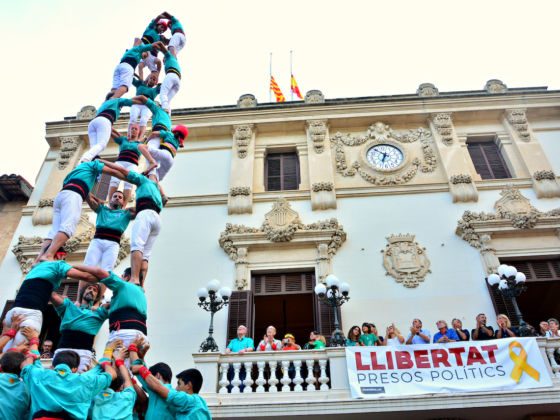At the dawn of my year abroad in Barcelona, I started poking around for an extracurricular activity. I wanted something that would let me practice Spanish and meet locals at the same time, which was turning out to be harder than expected in such a cosmopolitan city. I found what I was looking for in the Castellers of Barcelona, a local team carrying forward the 18th-century Catalan tradition of building castells, or human towers.


This seemingly bizarre local custom involves stacking standing participants on top of one another to construct towers up to 10 levels high. According to UNESCO, it’s among the “Masterpieces of the Oral and Intangible Heritage of Humanity,” and when I look at a fully constructed castell, I’m inclined to agree.
It’s been amazing to me how much community spirit and culture comes from an activity that’s literally nothing more than putting people on top of each other. The autonomous region of Catalonia has always been disparaged, or outright disenfranchised, by the central Spanish state, especially so during the reign of dictator Francisco Franco when the language itself was outlawed.
Of course, that means Catalans today are incredibly proud of their cultural heritage, of which the castells are a prime component. This makes for a whole new dimension of “team spirit” — people bring the same pride and heart to our practices that they feel towards Catalonia, and a quick look at the government’s recent independence proposals, or at any graffiti-ed wall in Barcelona, gives you a sense of how strong that is.
I never encountered such powerful comradery in any of my past organized sports teams. In every tower, before my field of vision is eclipsed completely by a hairy Catalan neck, all I can see are gathering, ready faces around me, nodding and winking jovially at each other.
Yet it’s not just the culture that brings these people together — the very nature of the act requires a wide variety of body types. I can’t think of another physical activity that allows people from such a large range of sizes and ages to contribute equally. There are entire families here: the heavyset dad that helps form the pinya (those who stand on the ground and support the tower); the young boy who’s still light enough to stand a few levels up in the tower; the shorter wife, whose shoulder height makes her perfect to help support the outstretched arms of the lowest layer; and even the six-year-old daughter, whose insignificant weight and tiny size make her perfect for scrambling up others’ backs to reach the very top. It brings together Catalans, and it gives parents and kids a novel way to spend time together.
I’m a tall, heavy guy, so I am always in the pinya, where my height and long arms allow me to effectively help support the buttocks of the second level. As the tower goes up, I’m held in place on all sides by other members of the pinya exerting firm force inwards, my head tucked into the neck of the man in front of me for safety, my sore arms outstretched to support the guy above me, while I sense successively lighter pairs of feet stepping onto and leaving my shoulders as they ascend upwards. You really feel important inside there — like you’ve entered a communal zen mode where everyone is silent and focused on helping one another do the same thing.
During showcases, when we’re all dressed up in the same color and performing in front of the local town government to dozens of spectators and mounting applause, the feeling is extraordinary.
And I’m repeatedly taken aback by how nice everyone is to the fresh-faced Californian. Although the ambient language and the coach’s commands are in Catalan, everyone speaks Castellaño (or “Spanish,” as we North Americans call it) to me, which means at least four hours of conversation practice every week. They welcomed me out of nowhere with smiles and advice and continue to help me adjust my technique, like knowing when to apply more force and how exactly to grip others’ wrists. I’ve made local friends my age, as well as people from walks of life I would never interact with otherwise, such as tattooed 30-something dads and the veteran castellers whose stooped shoulders somehow still provide adequate support after all these years of letting people stand on top of them.
And before you ask, yes, people do fall occasionally, though not nearly as much as you’d think — my team hasn’t fallen once all year, and there have been only two recorded castell deaths in recent history. I must admit, when I saw my first castells at the La Merce festival last September, I wanted nothing more than to watch them fall, so I could catch it on video, but these days I’m willing the same thing just as hard, except in the other direction. I think that’s reasonable, given the other crucial function of the pinya is to provide cushioning if the tower fails.
Talk about something that would never happen in America.